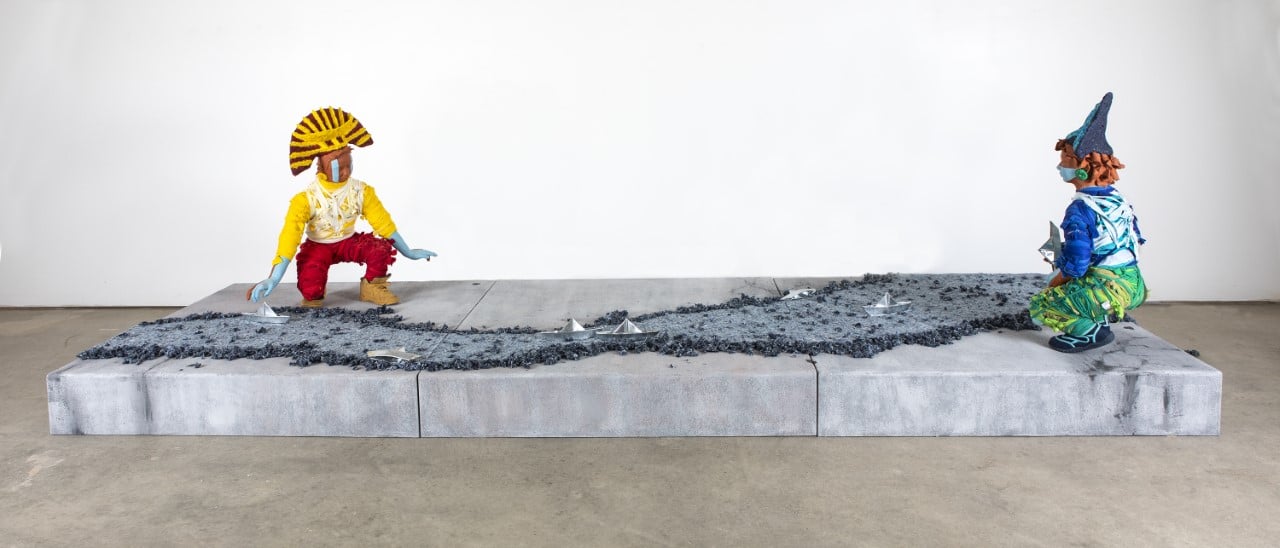
The Midwest, like all geographic regions, is both a place and an idea. The phrase might conjure a set of symbols as much as it does a description of physical boundaries: a casserole, a cornfield, a chicken coop.
In organizing “The Regional,” the first multi-museum survey of contemporary Midwestern artists now on view through March 20, 2022, at the Contemporary Arts Center (CAC) in Cincinnati, curators Amara Antilla and Jade Powers avoided all these and any other preconceived notions about the region or its artists. “We made a point not to go into this with a curatorial thesis or an overarching idea or set of themes in mind,” said Antilla, a senior curator at the CAC.
Instead, they decided, the shape of the show would rest entirely in the hands of its 23 artists, including Matthew Angelo Harrison, Devan Shimoyama, and Nikki Woods, among others. (Altogether, 14 different cities and 10 states are represented.)
Hellen Ascoli, Touch Over Fear (2020). Courtesy of the artist and Proyectos Ultravioleta, Guatemala City.
Early on in the process, the artists, along with the curators, all got together over Zoom for a group discussion. “It was an opportunity to talk about your practice, to think through how your work is related to someone else’s work who might be several states over,” said Powers, assistant curator at the Kemper Museum of Contemporary Art in Kansas City, where the exhibition will travel in June of next year. She called the conversations “potent and generative.”
Sure enough, it was there that the identity of “The Regional” really took hold, as the artists, who were initially bound together only by location, identified myriad common concerns.
Margo Wolowiec, Breaking News (2018). Courtesy of the artist and Jessica Silverman, San Francisco.
Land use, geographical borders, and the environment are major interests among the group, particularly for artists like Detroit’s Margo Wolowiec, who here turns both original and found photographs of contaminated waters into woven collages both dense and fragile; and Hellen Ascoli, a Guatemalan artist previously based in Madison, Wis., whose own patchwork textiles refer to the immigration crisis.
Ascoli’s efforts speak to another key theme as well: the immigrant experience. It’s overt in the work of Minnesota-based photographer Pao Houa Her, for instance, whose series Coming Off the Metal Bird (2006–09) comprises pictures of her Hmong community adjusting to life in America. “Instead of a narrative, [the project] was more about my own opinions and answering questions about life in America and what America is,” the artist explains in the exhibition’s digital catalogue.
Meanwhile, for his part, the ceramist Jonathan Christensen Caballero, based in Lawrence, Kan., offers up an allegorical sculpture. Spanning more than 13 feet, it depicts two relatives on either side of a river sailing small boats toward one another, as if communicating across borders of both time and place.
Pao Houa Her, Aunty Mai’s 3 daughters (2006–09). Courtesy of the artist and Bockley Gallery, Minneapolis.
Antilla and Powers may have approached “The Regional” without a thematic conceit, but they weren’t without goals. In their joint essay for the catalogue, their aims were framed in the form of questions: “How might we support a regional conversation and prop up local artists?” they wrote. “How might we foster conversations between our cities and the many other vibrant hubs throughout the Midwest? What are the values of living and working outside of conventional ‘art hubs,’ financial and otherwise?”
In each case, the answers came back to a sense of community—something in which artists throughout the Midwest are particularly invested, the curators explained.
“It was exciting to hear how interested these artists were in making those connections and getting to know other artists throughout the region,” said Antilla.
“Even though they are not on either coast, there is still a strong sense of community and artistic conversation,” Powers added. “There’s a real vibrancy in the Midwest art scene that maybe isn’t always recognized.”